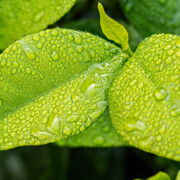Rainwater as a Resource for Your Landscaping
During the rainy season, runoff from hard surfaces around the home such as roofs and patios can be directed to the permeable landscaping. By capturing as much rainwater as possible in the soil, it is possible to build an ecosystem that can last through the summer months with minimal additional irrigation.
The entire built environment can be re-imagined and transformed into a living sponge. If more rain falls than can be absorbed, or if the soil is particularly impermeable, rainwater can be directed through landscaped areas to remove pollutants before it flows downstream.
Adjusting systems to maximize rainwater capture
There are three basic steps to capturing rainwater. First, check your roof to determine where precipitation is directed after it hits the surface — whether into rain gutters, off the edge, or elsewhere. Second, choose how and where to hold excess rainwater based on this assessment. Last, consider making upgrades such as adding rain barrels or making changes in your landscaping. For instance, landscaping soil may need amendments to hold more water.
Is your soil more like a brick or a sponge?
If your soil is more like a brick, it will affect how landscaping is contoured to capture water. Adding soil amendments will help it become more like a sponge that retains water for drier weeks and month. If the soil doesn’t drain well, take special care to avoid drowning new plants.
When choosing landscaping plants, match them to the soil type. If the soil is sandy, look for plants with “dry feet” that prefer free-draining soil, If the soil is harder clay, look for plants that do not mind heavy soil.
Optimal landscape soil can capture rainwater and allow it to soak in completely in 24 to 48 hours.
Many homeowners also use rain barrels to capture rainfall before it reaches the ground so it can be released during dry times. For more information about rain barrels, go to WaterSmartSD.org for information about purchase, rebates, and a one-minute video guide to installation.
This article was inspired by the 71-page Sustainable Landscapes Program guidebook available at SustainableLandscapesSD.org. The Water Authority and its partners also offer other great resources for landscaping upgrades, including free WaterSmart classes at WaterSmartSD.org.



